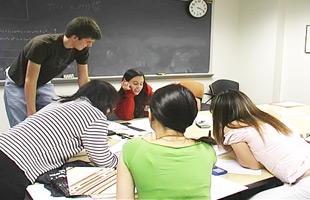Peer-Led Team Learning (PLTL) is an evidence-based method of small-group peer learning used at colleges and universities all over the world. PLTL groups typically consist of 6-8 students who work together to solve problems, and are facilitated by a Peer Leader. More information about this national pedagogy can be found at The Center for Peer-Led Team Learning and the Peer-Led Team Learning International Society websites.
 The PLTL program at Washington University in St. Louis (WUSTL) was introduced in General Chemistry in 2001. The model has expanded to Calculus and Introductory Physics and is being translated for Engineering courses.
The PLTL program at Washington University in St. Louis (WUSTL) was introduced in General Chemistry in 2001. The model has expanded to Calculus and Introductory Physics and is being translated for Engineering courses.
Characteristic elements of PLTL at WUSTL include:
- Explicit focus on process development goals
- Volunteer Enrollment
- Robust peer leader training
Research on PLTL at Washington University has demonstrated our model’s effectiveness in improving student learning. This website provides details about the philosophy behind our model, as well as its structure. It also presents resources for institutions that consider duplicating our model.
Student Comments
“PLTL has helped me most by allowing me to talk through the material and interact with others regarding chemistry. This really helps in my learning of the content.”
“I appreciated the extra problems that really tested my understanding of the material.”
“PLTL helped me think about the concepts in a new light.”
“I think PLTL was an excellent way to review and better understand the material.”
“Through PLTL I learned how to solve challenging problems and communicate strategies to others.”
“Problem solving. The online homework has its place as a tool to solidify fundamental understanding but learning how to apply knowledge and the process of doing so is crucially lacking in the online homework, and PLTL fixed that wonderfully.”
More Information
For more information please visit The Learning Center.